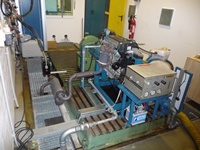Engine test bench with fourstroke spark ignition engine brake

Aim
Teaching in the framework of the Internal Combustion Engine (ICE) lecture includes laboratory training at an engine test bench with a four-stroke spark ignition engine. in this hands-on project the behavior of an ICE is investigated and mapped in an engine performance map. The energy balance is drawn for different engine loads for the whole range of operating conditions. This is done by varying torque and rotary speed and measuring the fuel consumption. From these data all necessary characteristic parameters like mean effective pressure pme and specific fuel consumption be can be calculated. The engine performance map is limited by several parameters. The range of speeds is restricted by minimum nmin and maximum nmax number of revolutions. The upper limit of engine power is given by the full load curve. For a complete energy balance the measurement of all power losses is necessary and done by measuring the temperature differences between entry and exit and the corresponding mass flows of cooling water, fuel/air mixture and exhaust gas. The concentrations of exhaust gas species are monitored as well.
Approach
The engine test bed is equipped with an eddy current brake which is able to handle engines with a maximum power of 50 kW and a maximum speed of 12,000 revolutions per minute alternatively on both sides of the brake flanges. The test bed is equipped with a 340 liter air vessel for minimizing fluctuations in the intake air flow rate which is measured with a hot film anemometer. The fuel consumption is measured by a continuous volumetric counter. Exhaust gas components like CO, CO2, NOx are detected by NDIR and residual hydrocarbons are measured by a FID. In case of Diesel engines the determination of the Bosch smoke number is possible.
References
Contact
Dr.-Ing. Ralf Starke, Ralf Starke,Tel: +49 (0)203 - 379 8165, IVG

